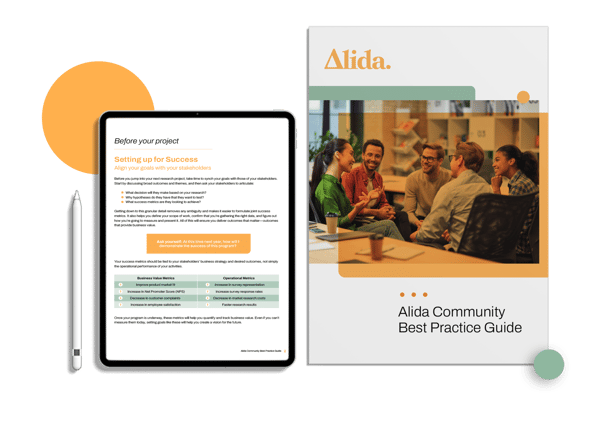Get the most out of your investment by following these tips to maintain your insight community.
Community management is about the practices and processes required to build and maintain a healthy and responsive online community. This is key to maintaining the flux of quality insights a well administered community is capable of.
But, what are these practices? These are the fundamentals you need to know to keep your community healthy and thriving.
How to diversify your community activities
Vary your activity type to keep your members engaged. Pay attention to which topics resonate among them.
Outside of surveys, other activities that serve that purpose are:
- Video feedback
- Photo uploads
- Forums
- Video discussions
- In-home usage testing
- Conversational surveys (SMS)
- Microsurveys
When organizing your activities, consider using the three-level approach:
Level 1 - Engagement Activity:
Tap into your marketing or PR teams’ plans for the year. Consider their promotions or announcements.
- Include information that members may be interested in.
- Review member comments from open end questions or member experience evaluation studies.
Level 2 - Strategic activity:
Consider your organization’s business needs and how your community can proactively help in decision-making. Look for opportunities to bring the voice of the customer into your company, such as marketing plans, sales presentations, and board meetings.
Level 3: Unplanned activity
Get involved in reactive initiatives for when sales are low, marketing needs testing, or the product team has a new idea and needs feedback. These are great opportunities to bring the community in to help inform and de-risk any decision-making.
By segmenting your activities as engagement, strategic, or unplanned, you’re ready to pivot as needed without overburdening your community members.
Where and how often to recruit
Community recruitment should be performed yearly —if not more often— if you have access to ongoing, appropriate channels. This should allow you to top up your community size throughout the year and get fresh voices in regularly.
Recruitment methods with higher join rates are:
- CRM database (email)
- Website banner or footer
- Newsletters
- Billing statements
- In-product packaging
- Digital displays
- Physical pamphlets
- Events (in-person, conferences, chats)
- Contact center
If embedding a ‘join’ link is not possible, incorporating a QR code for quick access to a recruitment survey is a good alternative.
When creating a recruitment invitation, remember audiences want to:
…understand what cause or effort the research will support;
…learn how their participation will help the organization;
…and see how their answers compare to others.
By keeping these factors in mind, you’re more likely to create a recruitment message that resonates with your prospective members.
Structure your invitation by answering the following questions:
- Why do you need them?
- What’s in it for them? (List only the benefits you’re certain to fulfill)
- How can you reassure your prospects about the legitimacy and confidentiality of the community?
- How can you humanize the tone of the invitation? (Use the “you” pronoun. If possible, sign with a name)
What to ask in a recruitment survey
A recruitment survey is meant to be a quick sign up experience in order to reduce friction for new members. While it’s true a recruitment survey is the only one likely to reach a 100% response rate, it’s best to break up some of the lesser ‘need-to-know’ variables and incorporate it into future studies to shorten the process.
You can get the most significant information you need in three steps:
Step 1 - Start with a “join us” study: Include two to three key need-to-know questions, along with the terms of agreement acceptance. Once completed, the prospective members can double opt-in.
Step 2 - Recruitment survey: New members receive an auto-deployed personalized welcome message and a quick activity (less than 5 minutes) to capture key demographics. Explain that the purpose of the survey is to ensure they’ll receive relevant activities in the future.
Step 3 - Welcome study / research study: Welcome surveys empower members to let you know what topics and methodologies they’re most interested in (e.g., surveys, video or forum discussions, other qualitative activities).
If there’s information you already have, hide the corresponding questions to prevent survey fatigue.
How to keep community members engaged
It’s important to be consistent with your sharebacks. Commit to sending a concise quarterly newsletter or a monthly e-update and members will be more likely to engage with you consistently.
Sharing back is important to your members because:
- It motivates them to stay
- Helps them understand the ‘why’ behind the ask
- Shows them how insight influences decision making
The perception of a two-way interaction promotes a long term and positive brand experience. Members are most interested in:
- What’s the outcome of an activity (decision made, business impact)
- What other members are thinking
- Recognition (being quoted or featured, receiving a shout out)
- Exclusive access to content (sneak peeks, direct interaction with experts or C-suite)
These are the most effective shareback methods:
- Hub post (monthly is optimal)
- E-update (via hub newsletter or survey invite, make concise, three items at most)
- Email invite or at the end of the survey
What is DSCUS
To close, here’s an acronym to help keep your communities engaged: DSCUS.
Dynamic: Use a mix of qualitative and quantitative activities.
Short: Keep surveys under five minutes.
Consistent: Avoid lull periods, aim for one activity a month, whether research or engagement-based. Use your organization’s research calendar as a resource.
Update: Keep profile variables up-to-date to ensure research topics resonate with the right members.
Share: Sharing outcomes is positively correlated with higher community experience satisfaction.
Remember, members are intrinsically motivated by the ability to learn something new and feel they’re helping with the decision-making process.
Register to download the Alida Community Best Practice Guide and make the most of your community.








